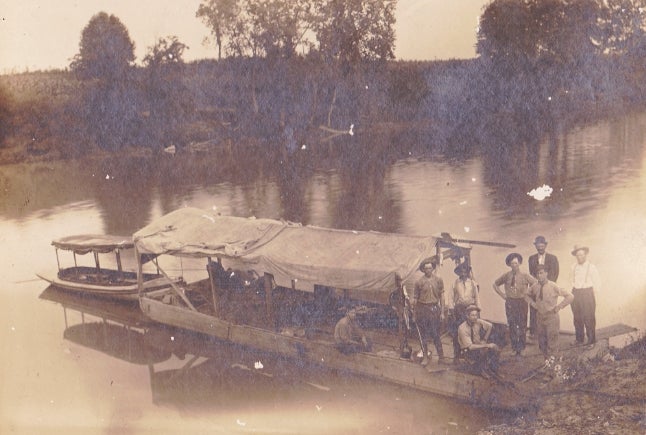Enoch: Origin of local road names
Published 10:00 am Saturday, July 29, 2023



|
Getting your Trinity Audio player ready...
|
By Harry Enoch
Contributing Writer
County road names can be obvious (Lexington Road, Mt. Sterling Road) or obscure (Nest Egg Road, Rabbittown Road). Many take the name of prominent Clark County families—Van Meter, Bybee, Fox-Quisenberry, Venable—while others are named for the creeks they follow—Pretty Run, Big Stoner, Dry Fork. Others have more interesting origins.
There are at least five roads with “Station” in their name. This does not refer to frontier defensive forts like Strode Station but rather to railroad stations that no longer exist. Both Flanagan Station and Elkin Station were located on the L&N rail line from Winchester to Richmond and were named for Judge James Flanagan (1810-1906) and the descendants of Rev. Robert Elkin (1745-1822). Renick Station, located on the L&N line between Winchester and Paris, took its name from the noted shorthorn dealer, Abram Renick (1803-1884). Mina Station was on the L&N route leading to Irvine and may have been named for Mrs. Mina Crow, whose husband was said to have helped establish the station. Hedges Station was located on the Elizabethtown, Lexington and Big Sandy Railroad (later the C&O) near Schollsville. It was named for Preston Hedges (1808-1899), on whose land the station was built in 1872.
We still have several roads named for mills, although the mills ceased to operate years ago. Wades Mill was named for William Wade (1813-1898), who operated a gristmill on Stoner Creek near the community of that name. Grimes Mill, built in about 1807 for Charles Grimes, was located just across Boone Creek in Fayette County. The building still stands and has long served as headquarters for the Iroquois Hunt Club. Stewarts Mill began life as Barzilla D. Abbott’s Mill, established in the early 1800s on Lulbegrud Creek in eastern Clark County. After Abbott’s death in 1850, the mill was operated by his son-in-law Marcus Swope, who sold it to Edward Stewart in 1866.
Three roads led to long-gone Kentucky River ferries. Combs Ferry was named for Samuel R. Combs, son-in-law of Col. John Holder who established a ferry at the mouth of Lower Howard’s Creek. Combs acquired the ferry rights from Holder’s heirs and then moved it about a mile downstream. Jackson Ferry, established in 1795, took its name from Josiah Jackson, a veteran of the Revolutionary War. His ferry crossed the river near the mouth of Muddy Creek, which is in Madison County. This has often created confusion, as our Muddy Creek Road is not named for a Clark County creek; near the river it changes its name to Jackson Ferry Road. A Latimore Road also branches off Red River Road near the Kentucky River. The 1877 Beers map of Madison County shows a “Laramore Ferry” in this vicinity. I have not learned who established the ferry.
There are still many roads left that do not fit into any of these categories. Basin Springs Road which runs between Combs Ferry Road and Colby Road, was named for the Basin Springs Branch, one of three branches that merge near Sulphur Well Road to form Boone Creek. At the site of the Sulphur Well on the Fayette County side of the creek, John McCall operated an early gristmill. The Sulphur Well may have been a well that produced sulfurous water.
Ironworks Road refers to KY 15, the highway between Winchester and Clay City in Powell County. Clay City was first known as Red River Iron Works, where Robert Clark Jr. and William Smith established Kentucky’s second iron furnace in about the year 1805. There was a second Ironworks Road in the 19th century. It went to the same ironworks but followed a more southerly route via Log Lick Road to the crossing of Lulbegrud Creek, and then becomes Snow Creek Road (KY 1028), and on to Clay City. This brings up a question about the origin of the name Log Lick. Located on Lulbegrud Creek, this buffalo lick was described by Daniel Boone in a well-known Clark County deposition in the year 1796. He said that in 1775 William and Major Beasley had cut a number of trees down there “in order to ketch Buffalows.”
I will close with three roads that remain a mystery. Rabbittown Road branches off to the southeast from Trapp-Goffs Corner Road. Rabbit Town, located at their intersection, was a crossroads community with several sawmills and stores. Lewis Pigg established a post office here that operated briefly as Chilton. The origin of the name Rabbit Town remains obscure. Some say it was a place overrun with rabbits; others opine that a schoolteacher in the village subsisted on a diet of rabbits.
Logans Lick Road runs between Muddy Creek Road and Old Ruckerville Road. Buffalo and other animals frequented licks to access their salty water. No historic licks have been reported in this area, nor is there any record of the famous Benjamin Logan in the neighborhood. Early Clark County Logans—William, Hugh and Nathaniel—did not own land in this area, so the origin of the name remains a mystery.
Finally, Nest Egg Road begins north of Kiddville and ends in Montgomery County. According to Allen Newkirk, who lives on the road, David Barrow (1753-1819) gave the Nest Egg Road its name. Barrow was a prominent pioneer Baptist preacher from Virginia who urged fellow Baptists to free their slaves. His famous work, entitled “Involuntary, Unmerited, Perpetual, Absolute, Hereditary Slavery, Examined on the Principles of Nature, Reason, Justice, Policy, and Scripture,” challenged slavery on every ground that proponents used to justify its existence. He died in Montgomery County in the area near Kiddville. Intriguing as it is, no clues have been found to explain the name.








